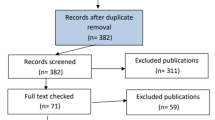Abstract
Background
The role of thyroidectomy as an early treatment for hyperthyroidism has been poorly investigated. Our aim was to examine its success rates, particularly focusing on thyroidectomy as an early treatment.
Methods
Patients with thyroidectomy for hyperthyroidism between February 2008 and October 2014 were included. They were divided into two groups (early and delayed thyroidectomy), and patient characteristics, treatment indications, complications and time to biochemical recovery were analyzed.
Results
Ninety-nine patients met the inclusion criteria, of whom 65 (66%) suffered from Graves’ disease, 25 (25%) from toxic goiters and 9 (9%) from amiodarone-induced hyperthyroidism. Structural abnormalities of the thyroid (39 patients, 39%) represented the most frequent indications for thyroidectomy. Forty-six patients (46%) underwent an early and 53 (54%) a delayed surgical approach. Patients with Graves’ disease undergoing early thyroidectomy did not suffer more often from complications but had a significantly faster biochemical recovery after surgery than those with a delayed thyroidectomy, as judged by a shorter time to reach TSH (121 ± 24 vs. 240 ± 31 days, p = 0.007) and fT4 (91 ± 29 vs. 183 ± 31 days p = 0.015) levels in the normal range. As expected, there were no recurrences of hyperthyroidism.
Conclusions
Early thyroidectomy was neither associated with permanent complications nor thyroid storm, but with a significantly improved biochemical recovery and therefore has to be recommended early in patients with Graves’ disease.

Similar content being viewed by others
References
Yip J, Lang BH, Lo CY (2012) Changing trend in surgical indication and management for Graves’ disease. Am J Surg 203:162–167
Ríos A, Rodríguez JM, Balsalobre MD et al (2005) Results of surgery for toxic multinodular goiter. Surg Today 35:901–906
Bahn RS, Burch HB, Cooper DS et al (2011) Hyperthyroidism and other causes of thyrotoxicosis: management guidelines of the American Thyroid Association and American Association of Clinical Endocrinologists. Endocr Pract 17:456–520
Cooper DS (2003) Antithyroid drugs in the management of patients with Graves’ disease: an evidence-based approach to therapeutic controversies. J Clin Endocrinol Metab 88:3474–3481
Yaqub A, Choudhry MI, Wheaton J et al (2011) Post-ablative hypothyroidism. W Va Med J 107:37–40
Metso S, Jaatinen P, Huhtala H et al (2004) Long-term follow-up study of radioiodine treatment of hyperthyroidism. Clin Endocrinol (Oxf) 61:641–648
Reid DJ (1987) Hyperthyroidism and hypothyroidism complicating the treatment of thyrotoxicosis. Br J Surg 74:1060–1062
Hyer SL, Newbold K, Harmer CL (2010) Early and late toxicity of radioiodine therapy: detection and management. Endocr Pract 16:1064–1070
Bakos B, Takács I, Nagy Z et al (2013) Long term efficacy of radioiodine treatment in hyperthyroidism. Exp Clin Endocrinol Diabetes 121:494–497
Szumowski P, Rogowski F, Abdelrazek S et al (2012) Iodine isotope 131I therapy for toxic nodular goitre: treatment efficacy parameters. Nucl Med Rev Cent East Eur 15:7–13
Bonnema SJ, Hegedüs L (2012) Radioiodine therapy in benign thyroid diseases: effects, side effects, and factors affecting therapeutic outcome. Endocr Rev 33:920–980
Bhatia KS, Lee YY, Yuen EH et al (2013) Ultrasound elastography in the head and neck. Part I. Basic principles and practical aspects. Cancer Imaging 13:253–259
Genovese BM, Noureldine SI, Gleeson EM et al (2013) What is the best definitive treatment for Graves’ disease? A systematic review of the existing literature. Ann Surg Oncol 20:660–667
Annerbo M, Stålberg P, Hellman P (2012) Management of Grave’s disease is improved by total thyroidectomy. World J Surg 36:1943–1946. doi:10.1007/s00268-012-1617-x
Witte J, Goretzki PE, Dotzenrath C et al (2000) Surgery for Graves’ disease: total versus subtotal thyroidectomy-results of a prospective randomized trial. World J Surg 24:1303–1311. doi:10.1186/1745-6215-13-234
Brent GA (2008) Clinical practice. Graves’ disease. N Engl J Med 358:2594–2605
Bartalena L, Brogioni S, Grasso L et al (1996) Treatment of amiodarone-induced thyrotoxicosis, a difficult challenge: results of a prospective study. J Clin Endocrinol Metab 81:2930–2933
Bogazzi F, Bartalena L, Martino E (2010) Approach to the patient with amiodarone-induced thyrotoxicosis. J Clin Endocrinol Metab 95:2529–2535
Franzese CB, Stack BC (2002) Amiodarone-induced thyrotoxicosis: a case for surgical management. Am J Otolaryngol 23:358–361
Gough J, Gough IR (2006) Total thyroidectomy for amiodarone-associated thyrotoxicosis in patients with severe cardiac disease. World J Surg 30:1957–1961. doi:10.1007/s00268-005-0673-x
Meerwein C, Vital D, Greutmann M et al (2014) Total thyroidectomy in patients with amiodarone-induced hyperthyroidism: when does the risk of conservative treatment exceed the risk of surgery? HNO 62:100–105
Phitayakorn R, Morales-Garcia D, Wanderer J et al (2013) Surgery for Graves’ disease: a 25-year perspective. Am J Surg 206:669–673
Sundaresh V, Brito JP, Wang Z et al (2013) Comparative effectiveness of therapies for Graves’ hyperthyroidism: a systematic review and network meta-analysis. J Clin Endocrinol Metab 98:3671–3677
Palit TK, Miller CC, Miltenburg DM (2000) The efficacy of thyroidectomy for Graves’ disease: a meta-analysis. J Surg Res 90:161–165
Barczyński M, Konturek A, Hubalewska-Dydejczyk A et al (2012) Randomized clinical trial of bilateral subtotal thyroidectomy versus total thyroidectomy for Graves’ disease with a 5-year follow-up. Br J Surg 99:515–522
Vasica G, O’Neill CJ, Sidhu SB et al (2012) Reoperative surgery for bilateral multinodular goitre in the era of total thyroidectomy. Br J Surg 99:688–692
Grodski S, Stalberg P, Robinson BG et al (2007) Surgery versus radioiodine therapy as definitive management for graves’ disease: the role of patient preference. Thyroid 17:157–160
Scerrino G, Morfino G, Paladino NC et al (2013) Does thyroid surgery for Graves’ disease improve health-related quality of life? Surg Today 43:1398–1405
Author information
Authors and Affiliations
Corresponding author
Ethics declarations
Conflict of interest
The authors declare that they have no competing interests.
Rights and permissions
About this article
Cite this article
Vital, D., Morand, G.B., Meerwein, C. et al. Early Timing of Thyroidectomy for Hyperthyroidism in Graves’ Disease Improves Biochemical Recovery. World J Surg 41, 2545–2550 (2017). https://doi.org/10.1007/s00268-017-4052-1
Published:
Issue Date:
DOI: https://doi.org/10.1007/s00268-017-4052-1



